This post may contain affiliate links. Please read our disclosure policy.
The delicious gluten free stuffing has tender chunks of toasty gluten free bread, aromatic vegetables, chicken stock, and an extra flavor boost from added vegetable bouillon, adds buttery texture to any meal.
It even travels well, something I know well since I've been making an entirely safe gluten free meal for my celiac son and taking it on the road for the holidays since he was a little boy!
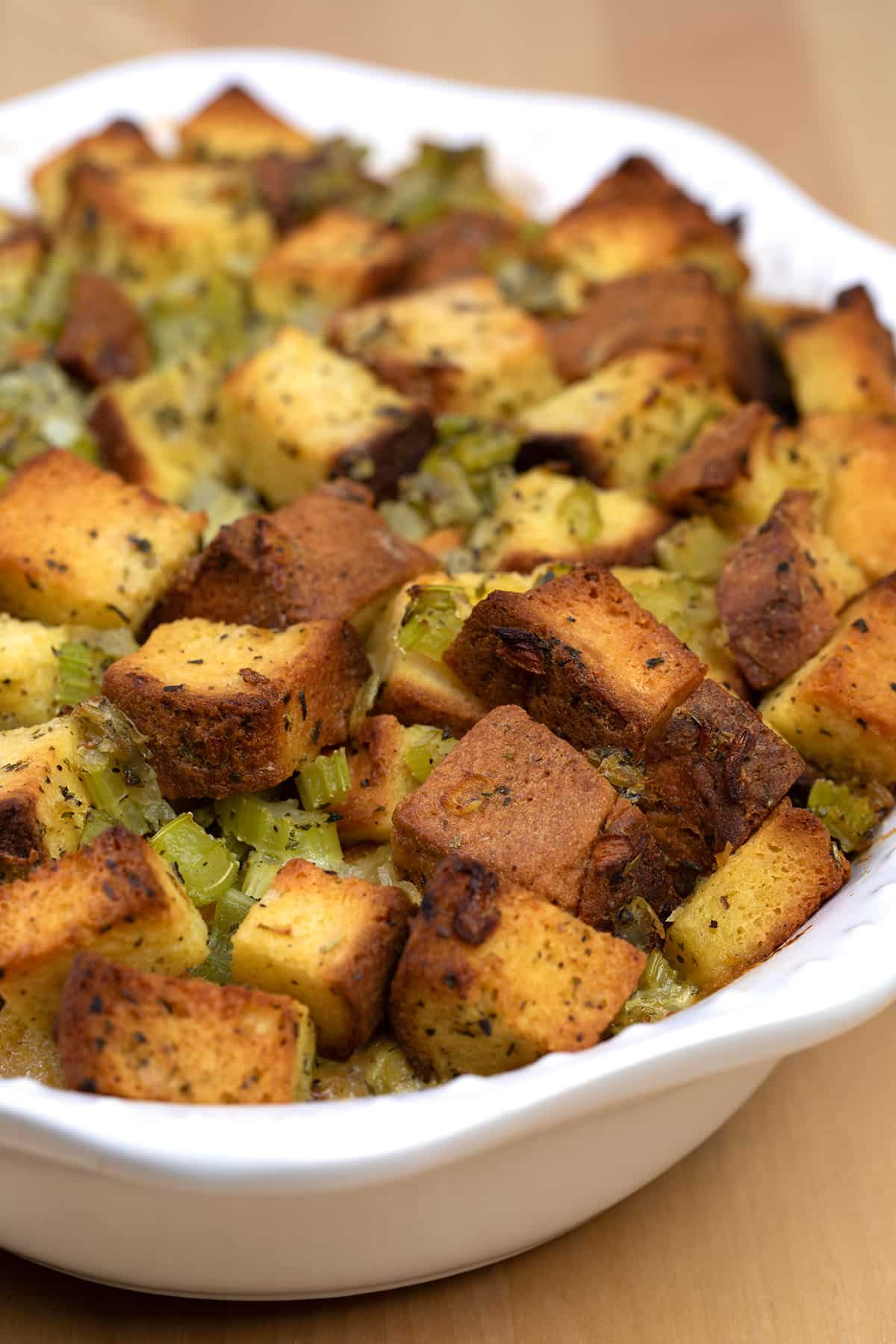
Why this recipe works
Preparing homemade stuffing might take longer than using a prepackaged mix from the store, but here's why the end result is worth the effort:
- Tons of flavor: There aren't a lot of ingredients in this stuffing, but the herbs, spices, and aromatics are present in just the right amounts for maximum flavor.
- Super moist: Drying out the bread in the oven first then adding just enough chicken stock and beaten eggs, along with onions, celery, and spices makes for a super moist stuffing
- Can prep bread ahead of time: Making the gluten free bread for the stuffing is the most time-consuming part, and it can be done days, if not weeks, ahead of time.
- Even good as leftovers: This stuffing is one of the only dishes made with bread or breadcrumbs that I actually almost prefer as leftovers, even straight from the refrigerator!
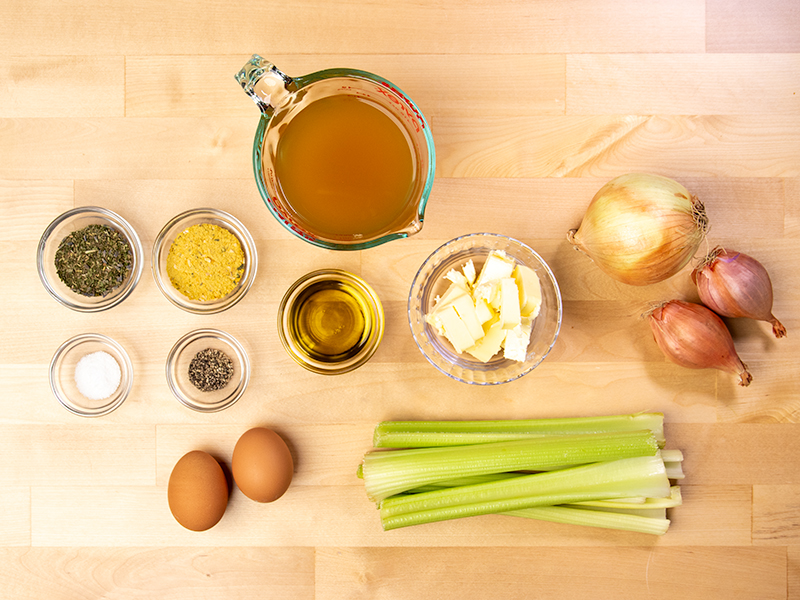
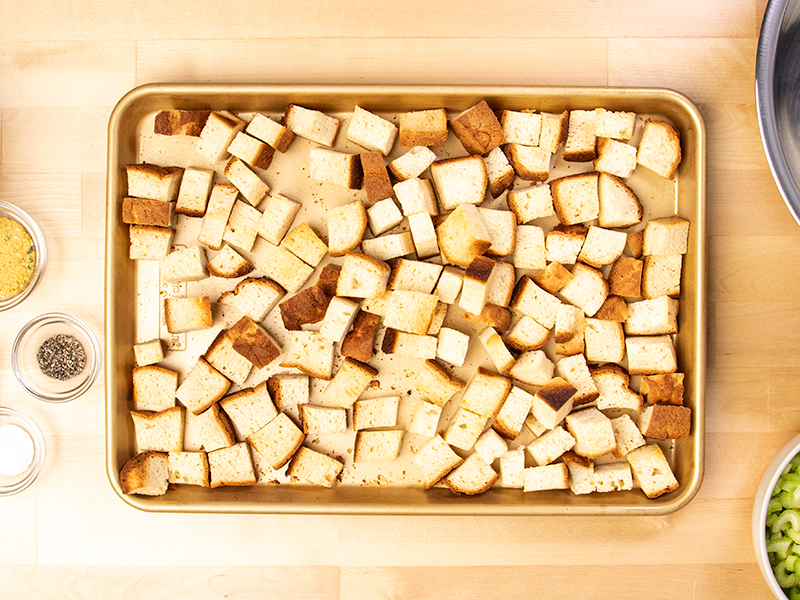
what's in it
Ingredient notes
- Gluten free bread: You'll need a full 1 pound loaf of gluten free bread for this recipe. My classic white gluten free bread recipe works great, and I also like to use my recipe for gluten free Japanese milk bread here. You can also use store-bought gluten free bread like Canyon Bakehouse; just cut it into cubes as large as you can. Dry-toasting this moist, enriched bread prepares it to absorb the flavors of the cooked vegetables and stock without turning mushy.
- Olive oil and butter: This combination adds richness, flavor, and helps to deliver the flavors of the aromatics.
- Onions & celery: These are your aromatics, cooked down without browning so they retain lots of their unique flavor and aroma. I like a combination of white onions and shallots.
- Salt & pepper: Enhance, brighten and balance the flavors in the dish.
- Vegetable bouillon: A simple mix of nutritional yeast flakes, minced dried onion, garlic powder, dried parsley, and dried thyme adds so much flavor. If you don't have nutritional yeast, you can try replacing it with a bit of finely grated Parmesan cheese. You can also replace the homemade vegetable bouillon with 2 tablespoons or 2 cubes of packaged gluten free chicken or vegetable bouillon.
- Poultry seasoning or herbs de Provence: Spice blends that add extra rich poultry aroma.
- Chicken stock: Moistens the bread and adds more flavor. You can use vegetable broth if you prefer, as long as it's flavorful.
- Eggs: Bind the dish together and also add some fat for richness.
Choosing the best gluten free bread for stuffing
When prepared and toasted just right, the right gluten free bread will make a stuffing that’s slightly crisp on some edges, but otherwise tender and soft, and never mushy or hard.
After testing and comparing, my favorite gluten free bread for Thanksgiving stuffing is my gluten free Japanese milk bread. It’s slightly enriched with an egg, some butter, a water roux for moisture retention, and milk, so it’s soft and tender.
This milk bread is soft enough that, when I bake it in a low, 300°F oven for about 40 minutes, it dries out and toasts lightly—but doesn’t harden. Since our basic white gluten free bread is also enriched with eggs, milk, and butter, it performs similarly and you shouldn't hesitate to use it here.
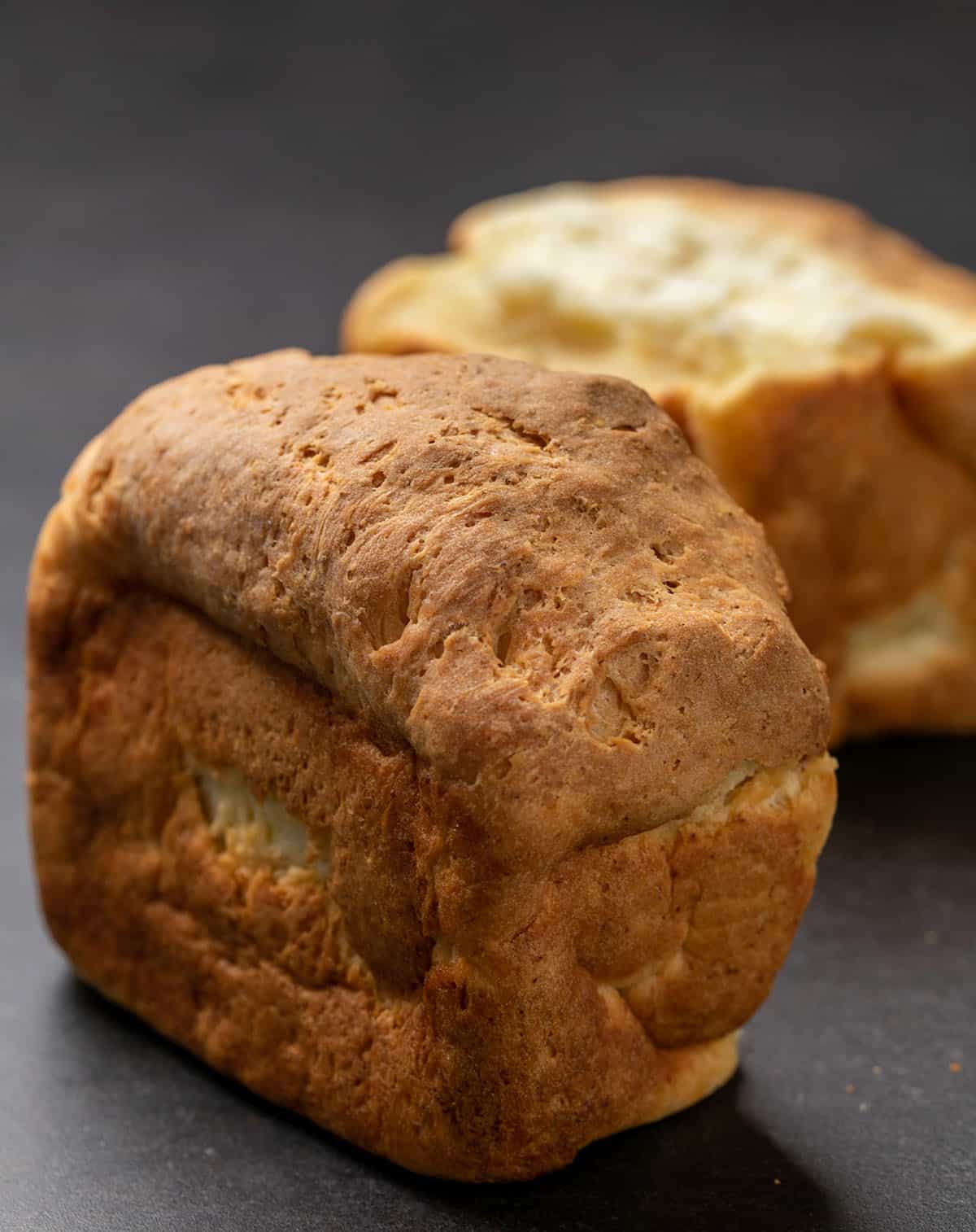
How to make gluten free stuffing
The full recipe card is below, but before you get started, I have a few important notes to share to ensure your stuffing comes out just right for the best stuffing:
1. Prepare the bread and aromatics
Cut your bread into cubes or tear it into rough pieces. Toast the bread until it's dry, but stop short of making it as crunchy as homemade gluten free croutons which would be hard to eat.
Cook down the onions, celery, herbs and seasoning in melted butter and olive oil until tender on low heat so they retain a lot of their natural flavors without burning.
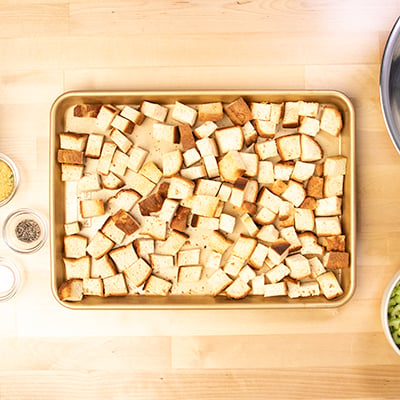
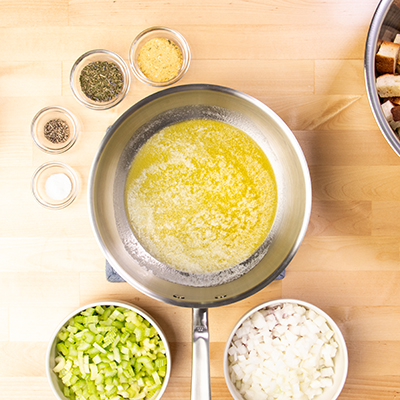
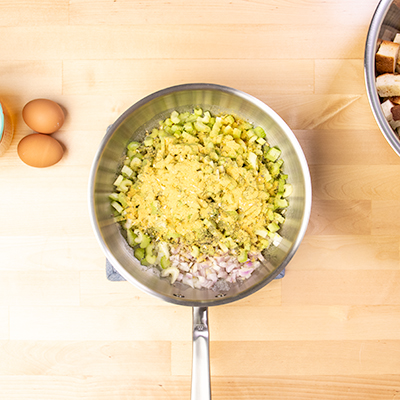
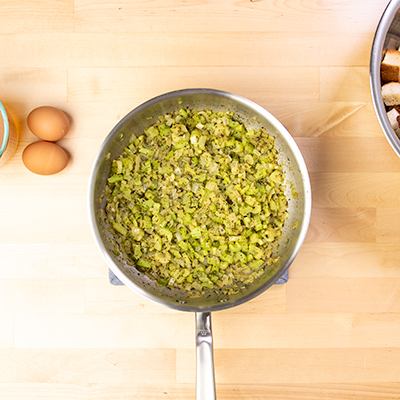
2. Combine & transfer
In a large bowl, add two eggs plus lots of flavorful chicken stock or vegetable stock to the aromatics and toasted bread to moisten and add flavor to the bread and bind the stuffing together.
Transfer to a buttered casserole dish and spread evenly in the dish to allow everything to bake fully and the dish to come together.
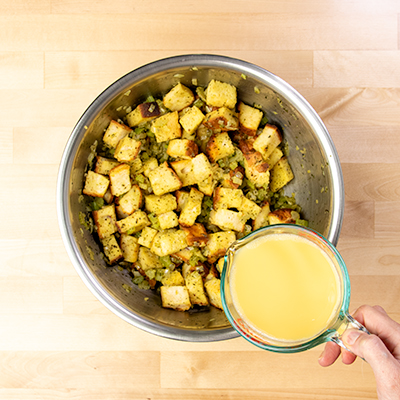
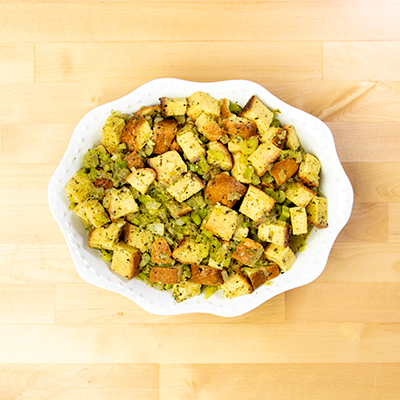
3. Bake and serve
Cover the dish first, so the eggs can set and the bread absorbs the liquids.
Bake the completed dish at 350°F for about 30 minutes, just long enough for the bread to fully absorb the flavors.
Uncover the baking dish and continue to bake for about another 30 minutes. This allows some of the excess moisture to bake off, the flavors to concentrate, and the edges of the bread to get toasty.
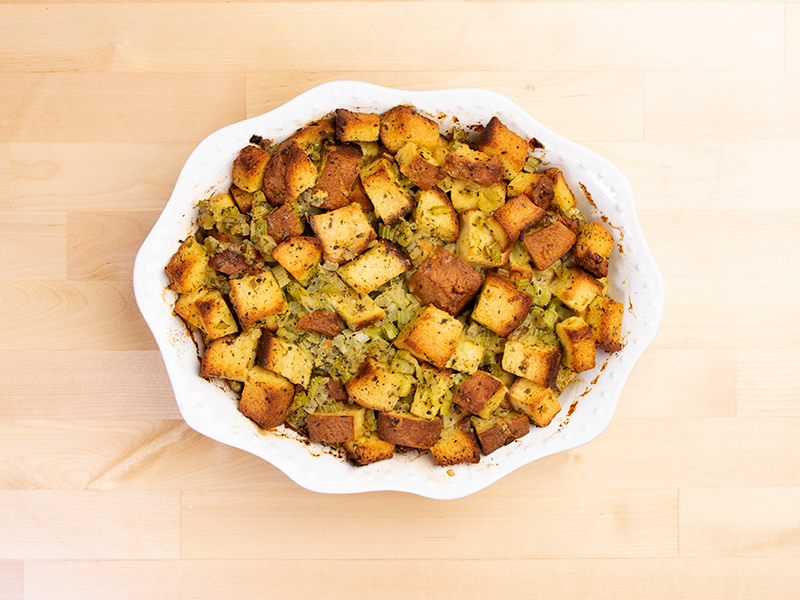
My Pro Tip
Recipe Tips & Tricks
This recipe is simple and versatile, but there are still a few tips to help make sure your stuffing is flawless:
Toast the bread low and slow
We’re using a loaf of bread that’s very soft inside with a thick, bakery-style crust outside. When we tear or slice it into pieces, we expose that tender center, which we then dry out in the oven.
Toast the bread and dehydrate it in a low, 300°F oven—don’t bake it. It takes some time, but this is how we create just the right textured bread to absorb all the flavors we will add.
Choose your bouillon carefully
Instead of making your own bouillon, you can use packaged gluten free bouillon. Unless the packaging specifically says that it's gluten free, I would avoid it. Herb Ox and Edward & Son’s Not Chick’N brands are gluten free.
Choose a high-quality stock that's rich and has good depth of flavor, like Pacific brand. Watery stock that doesn't have much flavor will lead to a much less flavorful dish.
Be gentle with the bread
When you mix the wet ingredients into the toasted bread chunks, don't be too forceful. Take it gently and steadily so you don't beat up the bread and cause it to break down too much.
Collect leftover pieces of bread all year
Save and freeze all of those ends and slices of gluten free bread in a freezer-safe ziptop bag. Then, whenever I need gluten free breadcrumbs, stale bread for stuffing, or homemade gluten free croutons, I’ve got the bread for it ready to go.
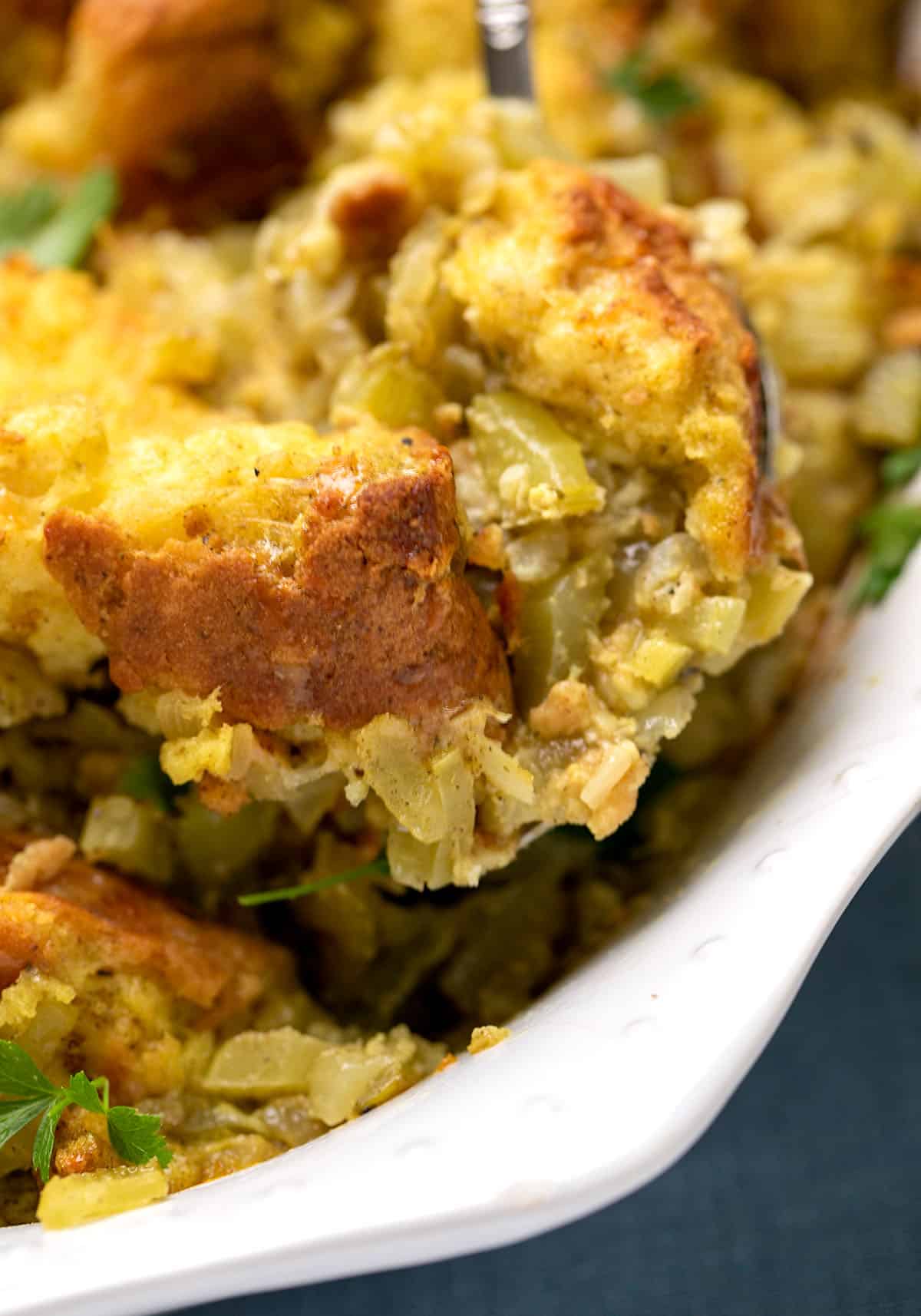
Ingredient substitutions
You can switch up this simple recipe to accommodate pretty much any dietary need. Just remember you may also need to tweak the bread recipe or choose a different bread, depending on the substitutions you want to make.
Dairy free
In place of the butter in this recipe and in the bread recipe, try using vegan butter (Melt and Miyoko’s Kitchen brands are best). For milk in the bread, use your favorite unsweetened nondairy milk, but make sure it's not nonfat. And just leave out the cheese or add more nutritional yeast for flavor.
Egg free
You can try using one “chia egg” instead of each egg in the recipe. I make a “chia egg” by combining one tablespoon ground white chia seeds with one tablespoon lukewarm water, and allowing it to sit until it gels.
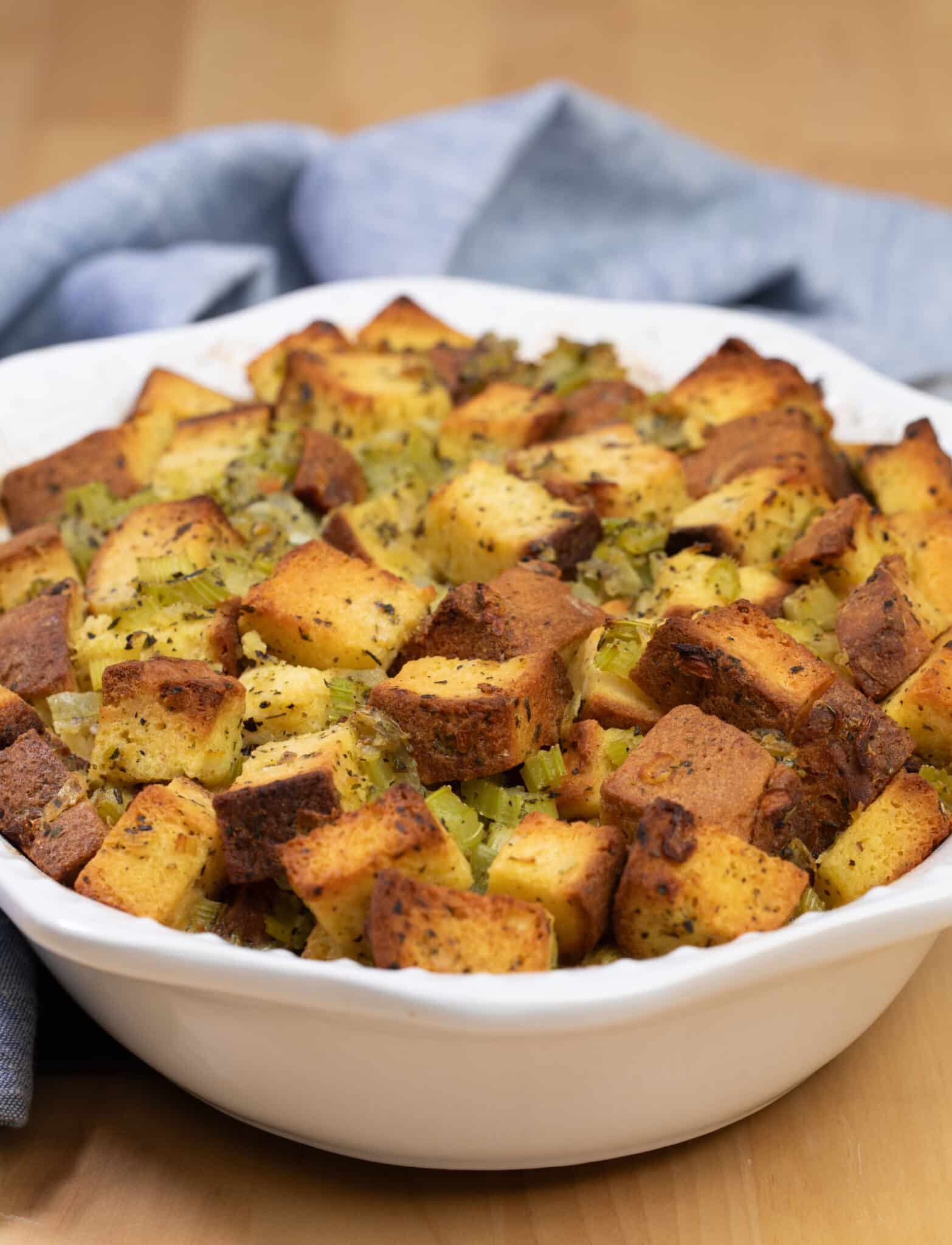
Gluten Free Stuffing Recipe
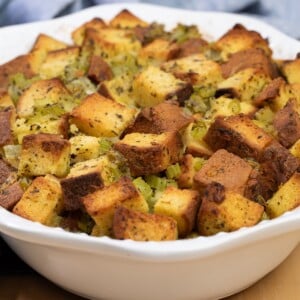
Ingredients
For the vegetable bouillon
- 1.5 tablespoons (8 g) nutritional yeast flakes, (See Recipe Notes)
- 1 teaspoon minced dried onion, can substitute 1/2 teaspoon onion powder
- ¼ teaspoon dried parsley
- ¼ teaspoon garlic powder
- ¼ teaspoon dried thyme
- ⅛ teaspoon dried turmeric, (optional)
For the stuffing
- 1 pound Gluten Free Japanese Milk Bread, See Recipe Notes
- 2 tablespoons (42 g) extra-virgin olive oil
- 6 tablespoons (84 g) unsalted butter, chopped
- 2 large yellow onions, peeled and diced (or a combination of onions and shallots)
- 2 cups chopped celery, from about 6 stalks celery
- 1 teaspoon kosher salt
- 1 teaspoon freshly ground black pepper
- 2 tablespoons vegetable bouillon, homemade vegetable bouillon powder or store-bought (See Recipe Notes)
- 2 tablespoons poultry seasoning, or herbs de Provence (See Recipe Notes)
- 2 (100 g (weighed out of shell)) eggs, at room temperature
- 1 ½ cups (12 fluid ounces) vegetable or chicken stock
- 1 ounce Parmigiano-Reggiano cheese, shredded (optional)
- 2 tablespoons unsalted butter, cubed for dotting on top of stuffing (optional)
Instructions
- Preheat your oven to 300°F. Grease well a 9-inch x 13-inch baking dish and set it aside.
- First, make the vegetable bouillon. In a small bowl, place the nutritional yeast flakes, minced dried onion, garlic powder, dried parsley, dried thyme, and optional turmeric, and whisk to combine. Set the bowl aside.
Toast the bread.
- Tear or slice the gluten free bread into roughly 1-inch pieces. Place them on a rimmed baking sheet.
- Place the baking sheet in the center of the 300°F oven, and bake for 30 to 40 minutes or until dried out and lightly browned.
- Continue to bake until the bread begins to shrink in size slightly and feels dry to the touch. It may take longer than 40 minutes depending on how moist the bread was at the start.
- Stir at least once halfway through baking, to ensure even baking. Remove from the oven and set aside to cool.
Cook the aromatics.
- In a medium-size, heavy-bottom saucepan, heat the butter and olive oil over medium heat until the butter is melted.
- Add the onion, celery, salt, pepper, vegetable bouillon, and poultry seasoning or herbs de Provence, and stir to combine.
- Reduce the heat to medium-low, cover and cook, stirring occasionally, until the onions and celery are fork-tender (about 10 minutes). The vegetables shouldn’t be mushy or even browned.
- Increase the oven temperature to 350°F.
Combine the stuffing ingredients and bake.
- Transfer the vegetable mixture to a large, heat-safe mixing bowl. Add the cooled toasted bread cubes, and mix to combine.
- Whisk together the eggs and stock until smooth. Add the egg mixture to the large mixing bowl, and toss carefully to coat.
- Add the optional shredded Parmigiano-Reggiano, and mix gently until just combined.
- Transfer the mixture carefully to the prepared 9-inch x 13-inch baking dish. Press it gently into an even layer.
- Scatter the final (optional) 2 tablespoons of cubed butter evenly across the top of the stuffing. Cover the baking dish securely with aluminum foil.
- Bake at 350°F for 30 minutes. Uncover, and continue to bake until the eggs are set and the stuffing is golden brown all over (about another 30 minutes).
- When it’s done, the stuffing will feel relatively firm when pressed gently with a finger in a thick portion. The top edges will be crisped but not dark. Serve warm.
Video
Notes
Nutrition
Nutrition information is automatically calculated, so should only be used as an approximation.
Variations
Creative twists on traditional stuffing
As long as you have the right type of gluten free bread and the correct proportions of eggs and stock, you can vary the flavors quite a bit. Whether you like sweet, meaty, or spicy, you can tweak this simple recipe to make your own family favorite:
Cranberry and apple
When cooking the onions and celery, add two peeled, cored, and diced apples, and one cup of dried cranberries to the aromatics when you add the stock.
Sausage
Cook 1 1/2 cups of crumbled bulk sausage until it is no longer pink. Remove the cooked sausage and set it aside, leaving behind the grease.
Add 1 to 2 tablespoons of olive oil, and cook the aromatics, replacing the sliced onions with 1 cup of cleaned and sliced leeks.
Tex-Mex cornbread
Replace the Japanese Milk Bread cubes with cubed Gluten Free Cornbread. Add 1 diced jalapeño pepper, ribs and seeds removed, and 1 seeded red bell pepper to the aromatics. After you add the stock, add 1 cup of frozen corn kernels. You can find more details on how to use cornbread in place of bread in our gluten free cornbread stuffing recipe.
make ahead/leftovers
Storage instructions
Leftover gluten free stuffing can be stored in an airtight container in the fridge to enjoy in the coming days. Zip-top bags work well here to stop the bread from losing its moisture. When ready, reheat the bread on low power in the microwave or oven.
If it's been more than a couple of days and if it's lost some moisture, try adding some gluten free turkey gravy if you have any left from the big day. And serve it alongside leftover cranberry sauce, too!
For longer storage, store extra stuffing in the freezer for up to three months in an airtight container. Defrost overnight in the refrigerator, sprinkle it lightly with lukewarm water, then bake at 300°F until warmed through.
FAQs
While there's technically a difference between the two, whether you use the word stuffing or dressing to describe the mixture of bread cubes, vegetables, and stock accompanying many turkeys on Thanksgiving is more likely to come down to where you live.
In the South, most people call this concoction with the savory flavor “dressing.” Up north, it tends to go by “stuffing.” In many regions, you can use either word, and people will know exactly what you mean. However, for purists, stuffing is the mixture that's cooked inside the turkey, while dressing is cooked to go beside it.
Yes! You can use your favorite packaged gluten free bread to make this stuffing. Just cut the slices into the largest pieces you can, and be sure to toast it until the bread is dry so it doesn't fall apart during baking.
If you routinely bake your own gluten free bread, definitely hold on to those ends and stale slices. Store them in the freezer until you have enough for a batch of gluten free turkey dressing, and your efforts will never go to waste.
Yes, you can use turkey drippings in place of some or all of the chicken broth or stock. The drippings will result in an even deeper, more intense flavor — just be sure to mix the drippings with water to thin them out to the right consistency.
Food safety is of paramount importance whenever you’re working with raw meat. According to the Cleveland Clinic’s website, it’s safe to eat dressing cooked inside a raw bird if you take certain precautions. Don’t add the stuffing ingredients until right before cooking. And make sure to test the dressing itself with an instant read thermometer and cook it until it reaches at least 165°F.
Yes! You can make the recipe through to baking it for the first 30 minutes, covered with foil. Remove the stuffing from the oven, leave the foil on, and allow it to cool to room temperature.
After it’s come to cool room temperature (it will take some time), remove the foil. Cover your make ahead gluten free stuffing with freezer-safe wrap (Glad Press n Seal works particularly well) and freeze. The day before you intend to serve the dish, defrost it in the refrigerator overnight. Remove it from the refrigerator and finish baking it, uncovered, according to the remaining recipe instructions.
I get it: When you're hustling and bustling to get food on the Thanksgiving dinner table, you may not want to think about adding gluten free stuffing from scratch to your list. Here are some prepackaged gluten free options that are worth trying for your next holiday meal if you're really pressed for time:
– Aleia's Savory Stuffing Mix
– Gillian's Gluten Free Homestyle Stuffing Mix
– Trader Joe's Gluten Free Stuffing Mix
Embracing a gluten free Thanksgiving
Whether you're cooking for gluten-intolerant family members or just want to try something new, this gluten free stuffing recipe is one you won't want to miss among your Thanksgiving recipes.
If you’re just starting your gluten-free journey, I have hundreds of tried and tested gluten free recipes for you to enjoy. You can view all my recipes and find ones you like. I also have a comprehensive guide to a gluten free diet, where I share some of the top benefits of embracing a gluten free lifestyle and some tips for navigating store-bought products.
Most of the main dishes for any big holiday, like turkey and ham, are naturally gluten free. So for us, it's all about the Thanksgiving recipes for side dishes!
In addition to this stuffing recipe, it wouldn't be the holidays for my family without a gluten free green bean casserole made with homemade gluten free cream of mushroom soup, and our favorite gluten free sweet potato casserole with the crumble topping. For dessert, gluten free pumpkin pie and gluten free apple pie are essential!
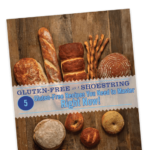

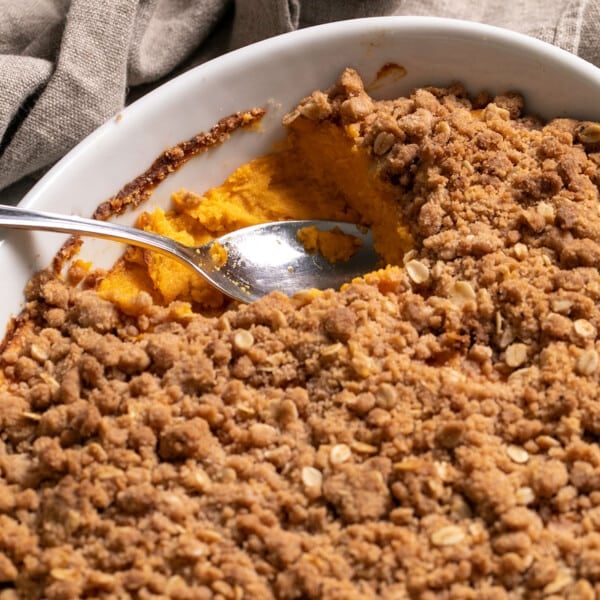
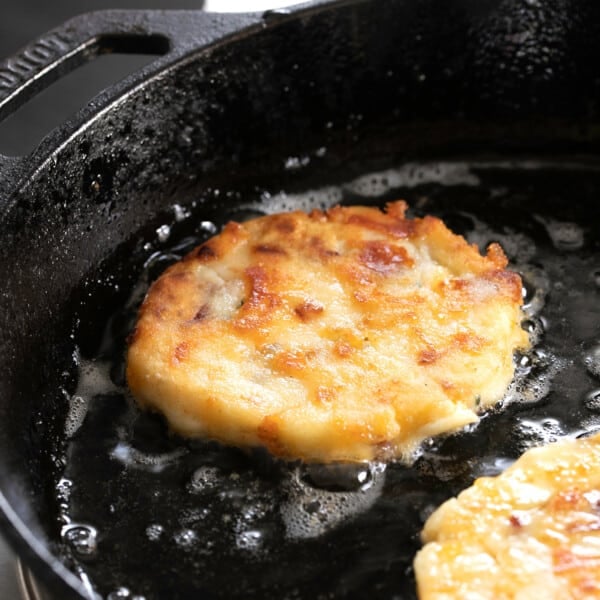
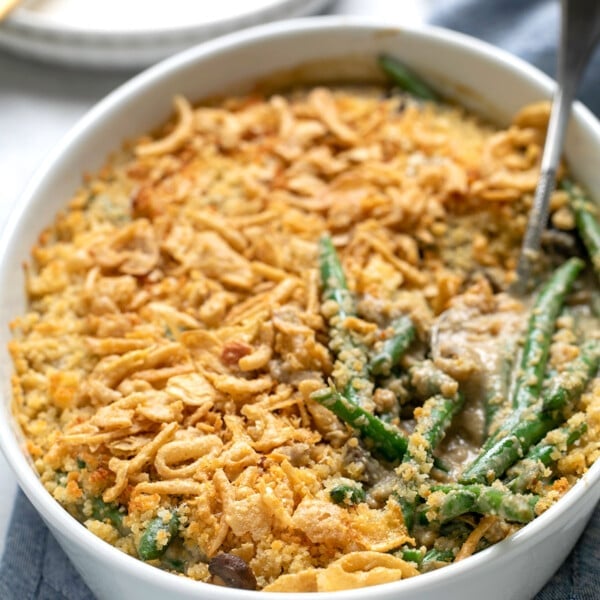
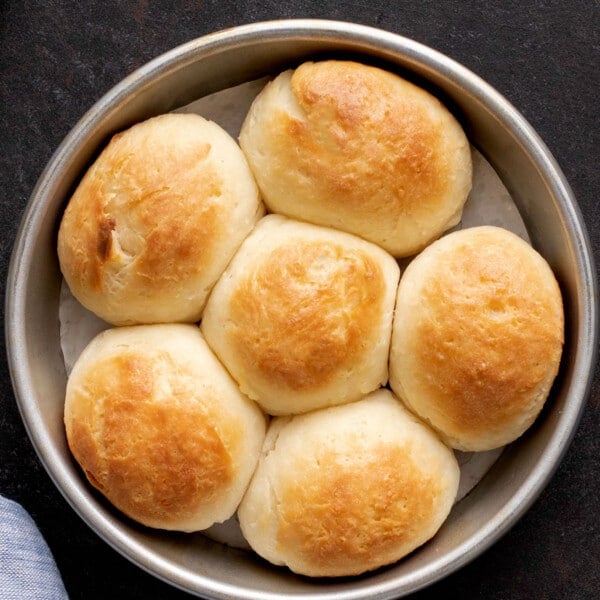









Hi Nicole ~ after many failed stuffing tries, I found your recipe to be amazingly good. Everything is perfect. Bread and Veg are in perfect harmony and proportion…texture is sublime, and the spices (from “scratch”) couldn’t be better. My family loved the taste and feel on the palate. Thank you for always working so hard ~ much appreciated! Best ~ Madelon
That’s so great to hear, Madelon. Thank you so much for sharing your experience!